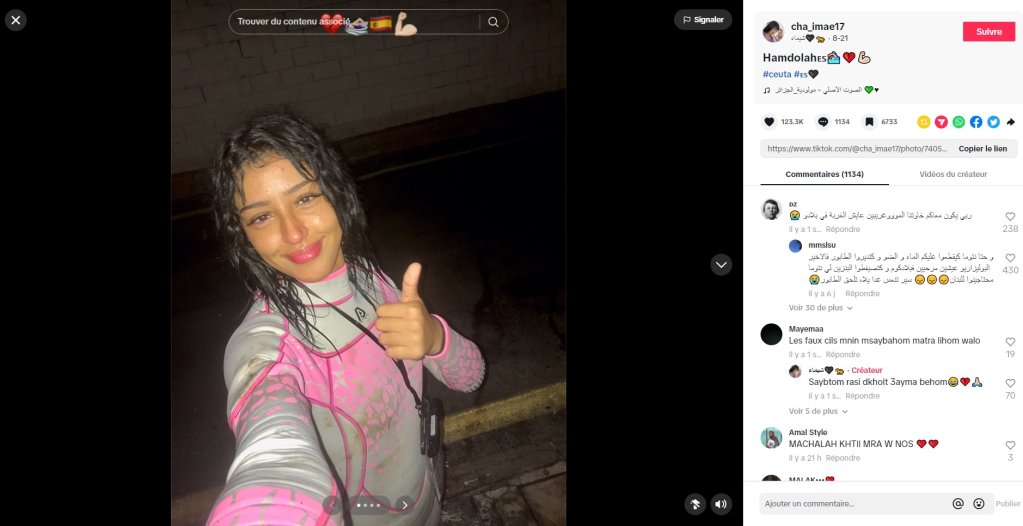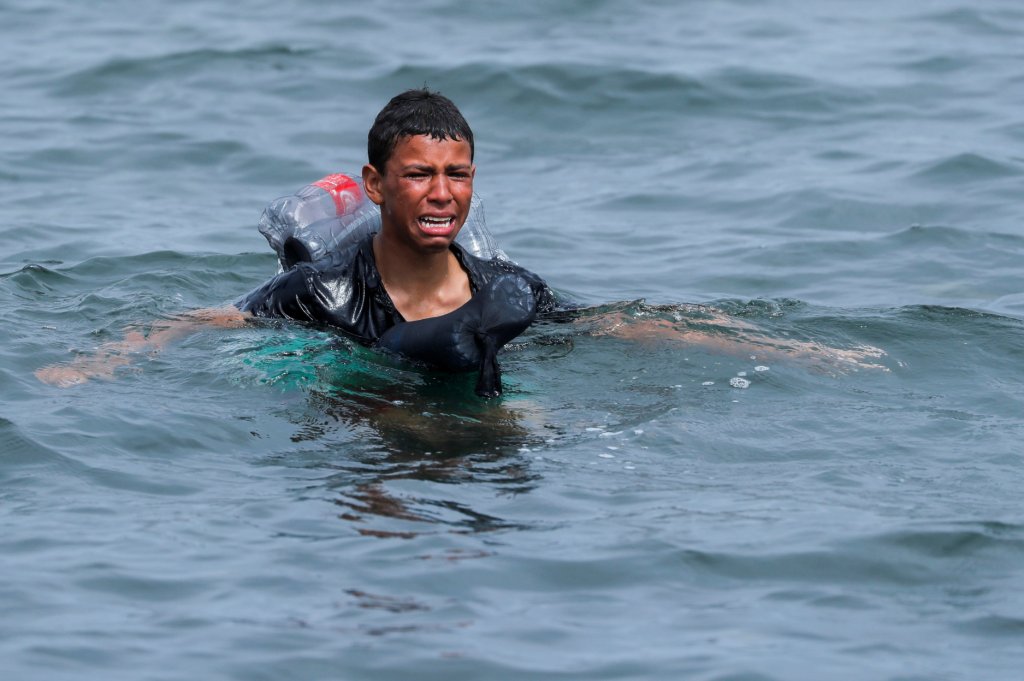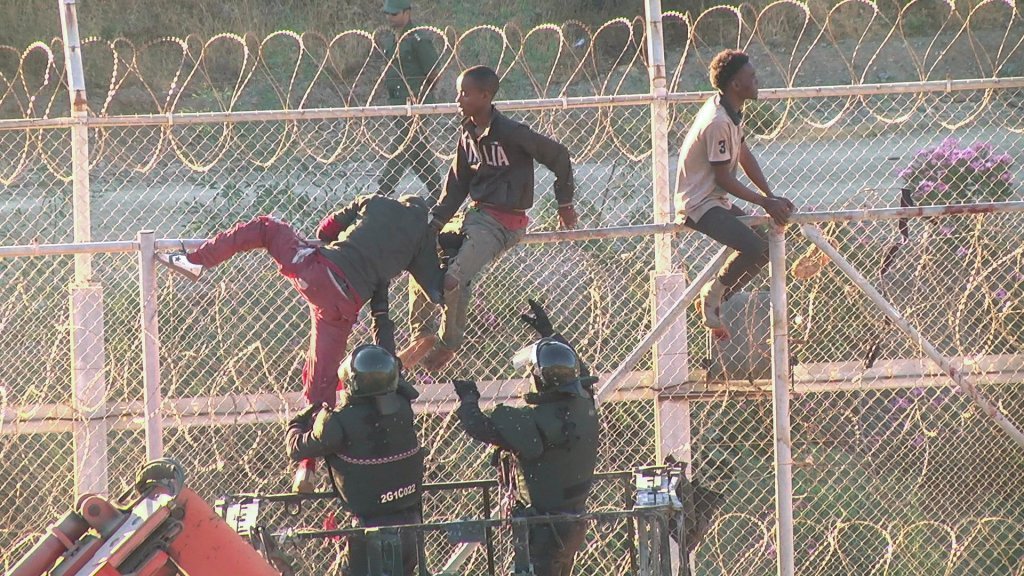For several months, a growing number of Moroccan migrants have been documenting their crossings to the Spanish enclave of Ceuta on social media. Images of Chaimae El Grini, a 19-year-old Moroccan woman smiling in a wetsuit and flippers as she lands on Spanish soil, have garnered millions of views. But behind that rosy picture, the reality is much more dangerous.
Each of her videos generate hundreds of thousands of views. In recent days, the posts of Chaimae El Grini, a 19-year-old Moroccan woman, have gone viral on the social network TikTok.
On her account, the first pinned post has two million views, a record for this Moroccan woman followed by more than 124,000 TikTokers. On August 21, she posted a picture: Chaimae El Grini, wet hair, appears smiling, dressed in a pink and gray diving suit, a plastic pouch around her neck to protect her phone from the water. She gives a victorious thumbs up. She also posted pictures of her in the streets of Spain, in a red miniskirt, green t-shirt, and a straw hat, smiling.

The young woman from Matril, in northern Morocco, is posting all over her TikTok about her journey to the Spanish enclave Ceuta, which along with Melilla, represents the only land borders between the European Union and Africa.
Chaimae El Grini shares every detail of her last crossing in mid-August to Ceuta, which followed four other failed attempts. She posts images of her in the back of a van on the way to the Moroccan-Spanish border, followed by videos showing her jumping into the water, then with a Spanish Red Cross blanket on her shoulders. Her posts offer a complete chronicle of her sea journey.
She also talks about her daily life in the enclave, posing smiling in front of Spanish buildings, in the streets and in what appears to be the reception center where she is housed.
Also read: Morocco intercepts over 1,100 migrants near Spain's Ceuta and Melilla exclaves
'I don't encourage others to do like me'
Like Chaimae El Grini, young Moroccans -- and more broadly Africans -- no longer hesitate to film their attempt to cross to Spanish soil, and share the images on social networks under the "harragas" (a term which means "border burners" and refers to migrants from the Maghreb) or "Ceuta" hashtags.
TikTokers detail the entire process: preparing equipment (mask, wetsuit, fins), techniques for hiding from Moroccan police, getting into the water and swimming. The ones who make it across also share photos parading in the streets of Ceuta, to the sound of triumphant music.

By showcasing the Ceuta crossing in this way, TikTokers only show part of the picture, obscuring the risks and deaths that can occur crossing the sea. Although the distance between the Spanish enclave and Moroccan territory is short, the journey is no less risky. The strong currents and rocks along the shore make the journey particularly dangerous.
Under Chaimae El Grini's posts, some users accused her of encouraging Moroccans to take to the sea. "I don't encourage others to do as I do," she told local media El Faro de Ceuta. "[The crossing] was very difficult, you have to be a good swimmer to do it (…) I had a lot of difficulty because the sea was very rough and the current takes you towards the rocks. No one can understand, except those who have already tried." The young Moroccan had to swim five hours nonstop to reach her goal.
Also read: Ceuta: Six people arrested over social media posts 'encouraging' migration
Many arrivals this summer in Ceuta
This summer, the enclave of Ceuta is facingis a high number of irregular migrant arrivals. On the night of August 25 to 26, some 300 young people, including many minors, set sail during the night, even though a significant haze had settled on the coast. Some were equipped with floats. Most were intercepted by the Moroccan navy, and about 80 people reached Spanish waters.
On Sunday morning, Spanish law enforcement had already evacuated Tarajal beach in Ceuta after Moroccan migrants, many of them minors, had reached the shore, El Faro de Ceuta reported.
In mid-August, about 300 other people had also crossed from Morocco to reach Ceuta.

Until 2020, swimming crossings to the Spanish enclave were almost non-existent, but they have intensified in recent years. "Before, many migrants wanting to enter Ceuta and Melilla hid in trailers, trucks, and cars heading there. But with the Covid-19 pandemic and the closure of land borders, would-be immigrants have looked for new ways to enter the enclaves, such as swimming," Moroccan researcher Ali Zoubeidi told InfoMigrants in 2021.
Climbing the triple barbed wire fences that separate Moroccan and Spanish territory has also become increasingly complicated. "Spanish and Moroccan controls have intensified around the roads, the land area and the fences," Ali Zoubeidi added. And then climbing the barbed wire often results in serious injuries: there are falls, blows from Spanish police officers. Some migrants therefore prefer to head out to sea, go around the fenced shore to try to reach the beaches of Ceuta and Melilla, risking their lives.
Also read: Spain: Top court rules deportation of child migrants 'illegal'
